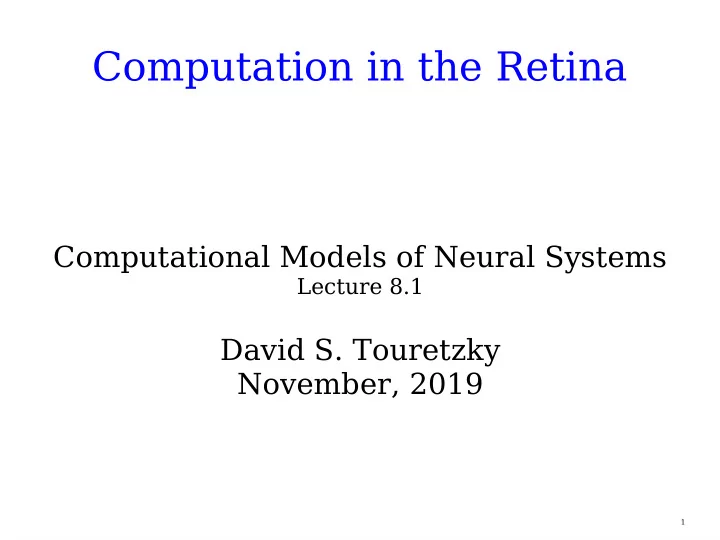

Computation in the Retina Computational Models of Neural Systems Lecture 8.1 David S. Touretzky November, 2019 1
Spatiotemporal Ganglion Cell Model From Meister & Berry, 1999: − t / A t = t − h ⋅ e temporal response 2 2 − x − x B ( x ) = k c ⋅ exp ( 2 ) − k s ⋅ exp ( 2 ) spatialresponse ( DoG ) 2r c 2r s R t = R 0 ∫∫ I x ,t' ⋅ B x ⋅ A t − t ' dx dt' 2
Response to Moving Bar (A) Simple ganglion cell model. (B) Responses of cat ON-type ganglion cell, and model. (C) Separate pathways for center and surround allows for difgerent response parameters. 3
Contrast Gain Control Cat ON-type X ganglion cell (jagged) and model response (smooth) 4
Cat Y Ganglion Cell Model ● Larger receptive fjeld than X cell. ● Up to 100 nonlinear subunits. ● Burst of spikes at spot onset and ofgset. ● Poor spatial resolution, but very sensitive to moving textures. ● What are the subunits? RFs are similar to X cells. 5
Analog Implementation of Neural Circuits ● Pioneered by Carver Mead at Caltech ● VLSI = Very Large Scale Integration ● CMOS = Complementary Metal Oxide Semiconductor ● CMOS is a low power implementation technology for fabricating VLSI chips 6
Analog vs. Digital VLSI ● Analog: direct analogy between circuit mechanisms and the computation being emulated. ● Digital: symbolic encoding of information and the rules for manipulating it. Slower than analog, but good for multiplexing. 7
Early Silicon Retina Models: Mahowald and Mead ● P: photoreceptor B: bipolar cell : horizontal cell ● Horizontal cells are connected to form a hexagonal resistive network, modeling the efgect of gap junctions. 8
Response to Flashing Light Stimulus of Varying Width Left: bipolar cell responses in the salamander. Right: output of a pixel in the silicon retina. 9
Zaghloul & Boahen (2004) ● Hexagonal array: each photoreceptor has six neighbors. ● Transient ganglion cells receive input from central photoreceptors and six neighboring sustained ganglion cells. 10
Pixel Layout P: photoreceptor OR: outer retina circuitry B: bipolar cells IR: inner retina circuitry GC: ganglion cells 11
Outer Retina Model CO = cone; CT = cone terminal; HC = horizontal cell 12
Outer Retina Circuit Phototransistors 13
Four Ganglion Cell Types Sustained Transient 14
Inner Retina NA = narrow fjeld amacrine cell WA = wide fjeld amacrine cell BC = bipolar cell OnS = “on” sustained ganglion cell; OnT = transient 15
Inner Retina Model 16
Inner Retina Circuit 17
Distribution of Firing Rates ● Histogram of fjring rates for the four types of ganglion cells. ● Spread shows variability in the pixels due to circuit properties and noise. 18
Response to Sinusoidal Grating ● 3 Hz 50% contrast sinusoidal grating stimulus. ● Four ganglion cell types: on vs. ofg center sustained vs. transient response 19
Response to Natural Images ● Top: response of four cell types to a face image. ● Bottom: image reconstructed from the ganglion cell responses. 20
Spike Generation CMOS circuit to generate ganglion cell spikes. Spike rate is a function of input current. spike reset 21
Address Event Representation ● How to get spikes ofg the chip? Not enough wires. ● Solution: go digital. Each time a cell spikes, put its address on the AER bus. ● Arbitration handles collisions. 22
Recommend
More recommend